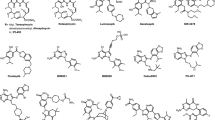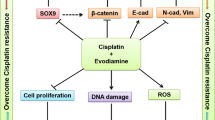Abstract
Treatment for advanced stages of hepatocellular carcinoma (HCC) remains unsatisfactory. While 5-fluorouracil (5-FU) and irinotecan are first-line treatment options for other gastrointestinal tumors, their effect on HCCs is low. Histone-deacetylase inhibitors such as suberoylanilide hydroxamic acid (SAHA) have shown antitumoral activity at micromolar concentrations in a variety of human cancers in vitro and in vivo. Here, we investigated the effects of a combination of 5-FU, irinotecan and SAHA on growth inhibition and apoptosis induction in HCC cell lines. HepG2, Hep1B and MH-7777A hepatoma cell lines and human foreskin fibroblasts as non-transformed controls were incubated with 5-FU, irinotecan and SAHA either alone or in combination. While the single agents did not show any effects on growth of the cell lines, the combination of 5-FU and irinotecan (both 10 μM) led to a moderate increase in apoptosis and proliferation inhibition. Adding 1 μM SAHA increased the apoptosis rate in hepatoma cell lines up to 92% after 72 h, while fibroblasts showed no response (5.5% apoptosis). Induction of apoptosis was paralleled by loss of the mitochondrial transmembrane potential, downregulation of bcl-2 expression and activation of caspase 3 but not caspase 8. In summary, SAHA sensitized HCC cell lines for treatment with an otherwise ineffective combination of 5-FU and irinotecan and led to mitochondrial apoptosis induction. The use of the triple combination could optimize treatment results in vivo and needs further evaluation.






Similar content being viewed by others
References
Benson AB III, Mitchel E, Abramson N, Klencke B, Ritch P, Burnham JP, McGuirt C, Bonny T, Levin J, Hohneker J (2002) Oral eniluracil/5-fluorouracil in patients with inoperable hepatocellular carcinoma. Ann Oncol 13:576–581
Butler LM, Agus DB, Scher HI, Higgins B, Rose A, Cordon-Cardo C, Thaler HT, Rifkind RA, Marks PA, Richon VM (2000) Suberoylanilide hydroxamic acid, an inhibitor of histone deacetylase, suppresses the growth of prostate cancer cells in vitro and in vivo. Cancer Res 60:5165–5170
Butler LM, Zhou X, Xu WS, Scher HI, Rifkind RA, Marks PA, Richon VM (2002) The histone deacetylase inhibitor SAHA arrests cancer cell growth, up-regulates thioredoxin-binding protein-2, and down-regulates thioredoxin. Proc Natl Acad Sci U S A 99:11700–11705
Cance WG, Stewart AK, Menck HR (2000) The national cancer data base report on treatment patterns for hepatocellular carcinoma. Cancer 88:912–920
Cao S, Rustum YM (2000) Synergistic antitumor activity of irinotecan in combination with 5-fluorouracil in rats bearing advanced colorectal cancer: role of drug sequence and dose. Cancer Res 60:3717–3721
Diasia RB, Harris BE (1989) Clinical pharmacology of 5-fluorouracil. Clin Pharmacokinet 16:215–237
Gottesman MM, Pastan I (1993) Biochemistry of multidrug resistance mediated by the multidrug transporter. Annu Rev Biochem 62:385–427
Göttlicher M, Minucci S, Zhu P, Krämer OH, Schimpf A, Giavara S, Sleeman JP, Lo Coco F, Nervi C, Pelicci PG, Heinzel T (2001) Valproic acid defines a novel class of HDAC inhibitors inducing differentiation of transformed cells. EMBO J 20:6969–6978
Guichard S, Cussac D, Hennebelle I, Bugat R, Canal P (1997) Sequence-dependent activity of the irinotecan-5FU combination in human colon-cancer model HT-29 in vitro and in vivo. Int J Cancer 73:729–734
Guichard S, Hennebelle I, Bugat R, Canal P (1998) Cellular interactions of 5-fluorouracil and the camptothecin analogue CPT-11 (irinotecan) in a human colorectal carcinoma cell line. Biochem Pharmacol 55:667–676
Gupta E, Wang X, Ramirez J, Ratain MJ (1997) Modulation of glucuronidation of SN-38, the active metabolite of irinotecan, by valproic acid and phenobarbital. Cancer Chemother Pharmacol 39:440–444
Henderson C, Mizzau M, Paroni G, Maestro R, Schneider C, Brancolini C (2003) Role of caspases, bid, and p53 in the apoptotic response triggered by histone deacetylase inhibitors trichostatin-A (TSA) and suberoylanilide hydroxamic acid (SAHA). J Biol Chem 278:12579–12589
Herold C, Ganslmayer M, Ocker M, Hermann M, Geerts A, Hahn EG, Schuppan D (2002) The histone-deacetylase inhibitor trichostatin A blocks proliferation and triggers apoptotic programs in hepatoma cells. J Hepatol 36:233–240
Johnstone RW (2002) Histone-deacetylase inhibitors: novel drugs for the treatment of cancer. Nat Rev Cancer 1:287–299
Lavelle D, Chen YH, Hankewych M, DeSimone J (2001) Histone deacetylase inhibitors increase p21waf1 and induce apoptosis of human myeloma cell lines independent of decreased IL-6 receptor expression. Am J Hematol 68:170–178
Leers MP, Kolgen W, Bjorklund V, Bergman T, Tribbick G, Persson B, Bjorklund P, Ramaekers FC, Bjorklund B, Nap M, Jornvall H, Schutte B (1999) Immunocytochemical detection and mapping of a cytokeratin 18 neo-epitope exposed during early apoptosis. J Pathol 187:567–572
Legrand O, Perrot JY, Simonin G, Baudard M, Marie JP (2001) JC-1: a very sensitive fluorescent probe to test Pgp activity in adult myeloid leukemia. Blood 97:502–508
Lin DY, Lin SM, Liaw YF (1997) Non-surgical treatment of hepatocellular carcinoma. J Gastroenterol Hepatol 12:S319–S328
Longley DB, Harkin DP, Johnston PG (2003) 5-Fluorouracil: mechanisms of action and clinical strategies. Nat Rev Cancer 3:330–338
Mancini M, Anderson BO, Caldwell E, Sedghinasab M, Paty PB, Hockenbery DM (1997) Mitochondrial proliferation and paradoxical membrane depolarization during terminal differentiation and apoptosis in a human colon carcinoma cell line. J Cell Biol 138:449–469
Marks PA, Richon VM, Rifkind RA (2000) Histone deacetylase inhibitors: inducers of differentiation or apoptosis of transformed cells. J Natl Cancer Inst 92:1210–1216
Mathurin P, Rixe O, Carbonell N, Bernard B, Cluzel P, Bellin MF, Khayat D, Opolon P, Poynard T (1998) Overview of medical treatments in unresectable hepatocellular carcinoma—an impossible meta-analysis? Aliment Pharmacol Ther 12:111–126
Okuda K (2000) Hepatocellular carcinoma. J Hepatol 32 [Suppl 1]:225–237
O’Reilly EM, Stuart KE, Sanz-Altamira PM, Schwartz GK, Steger CM, Raeburn L, Kemeny NE, Kelsen DP, Saltz LB (2001) A phase II study of irinotecan in patients with advanced hepatocellular carcinoma. Cancer 91:101–105
Pavillard V, Formento P, Rostagno P, Formento JL, Fischel JL, Francoual M, Etienne MC, Milano G (1998) Combination of irinotecan (CPT11) and 5-fluorouracil with an analysis of cellular determinants of drug activity. Biochem Pharmacol 56:1315–1322
Phiel CJ, Zhang F, Huang EY, Guenther MG, Lazar MA, Klein PS (2001) Histone deacetylase is a direct target of valproic acid, a potent anticonvulsant, mood stabilizer, and teratogen. J Biol Chem 276:36734–36741
Richon VM, Sandhoff TW, Rifkind RA, Marks PA (2000) Histone deacetylase inhibitor selectively induces p21waf1 expression and gene-associated histone acetylation. Proc Natl Acad Sci U S A 97:10014–10019
Rothenberg ML (2001) Irinotecan (CPT-11): recent developments and future directions—colorectal cancer and beyond. Oncologist 6:66–80
Ruefli AA, Bernhard D, Tainton KM, Kofler R, Smyth MJ, Johnstone RW (2002) Suberoylanilide hydroxamic acid (SAHA) overcomes multidrug resistance and induces cell death in p-glycoprotein-expressing cells. Int J Cancer 99:292–298
Sambucetti LC, Fischer DD, Zabludoff S, Kwon PO, Chamberlin H, Trogani N, Xu H, Cohen D (1999) Histone deacetylase inhibition selectively alters the activity and expression of cell cycle proteins leading to specific chromatin acetylation and antiproliferative effects. J Biol Chem 274:34930–34947
Smiley ST, Reers M, Mottola-Hartshorn C, Lin M, Chen A, Smith TW, Steele GD Jr, Chen LB (1991) Intracellular heterogeneity in mitochondrial membrane potentials revealed by a J-aggregate-forming lipophilic cation JC-1. Proc Natl Acad Sci U S A 88:3671–3675
Xu Y, Villalona-Calero MA (2002) Irinotecan: mechanisms of tumor resistance and novel strategies for modulating its activity. Ann Oncol 13:1841–1851
Yu AS, Keeffe EB (2003) Management of hepatocellular carcinoma. Rev Gastroenterol Disord 3:8–24
Acknowledgements
We thank S. Kareth, S. Leitner, A. Hartl and C. Kühl for excellent technical assistance. This work was supported by grants from the ELAN Program (Fund for Research and Teaching, University Erlangen-Nuernberg) and the FUTUR Program of the Bavarian Government.
Author information
Authors and Affiliations
Corresponding author
Additional information
M. Ocker and A. Alajati contributed equally to this work.
Rights and permissions
About this article
Cite this article
Ocker, M., Alajati, A., Ganslmayer, M. et al. The histone-deacetylase inhibitor SAHA potentiates proapoptotic effects of 5-fluorouracil and irinotecan in hepatoma cells. J Cancer Res Clin Oncol 131, 385–394 (2005). https://doi.org/10.1007/s00432-004-0664-6
Received:
Accepted:
Published:
Issue Date:
DOI: https://doi.org/10.1007/s00432-004-0664-6




